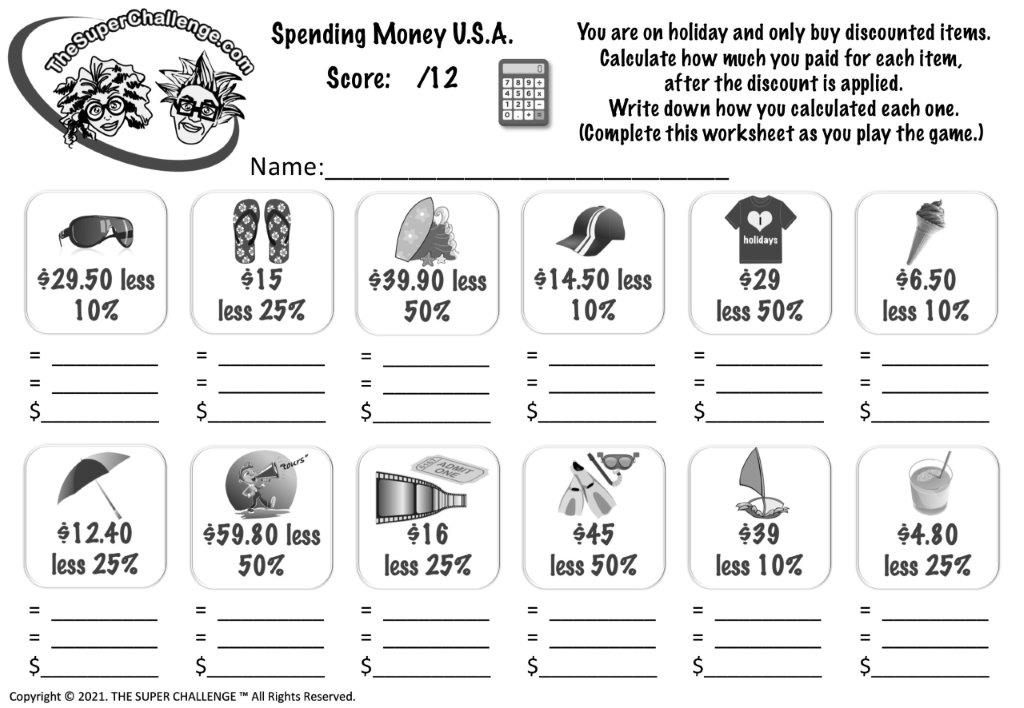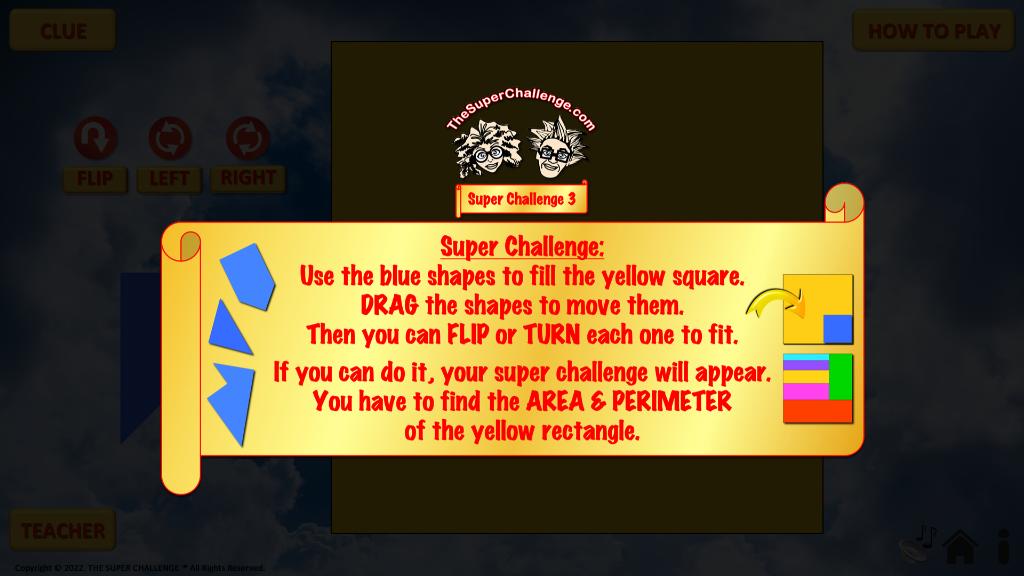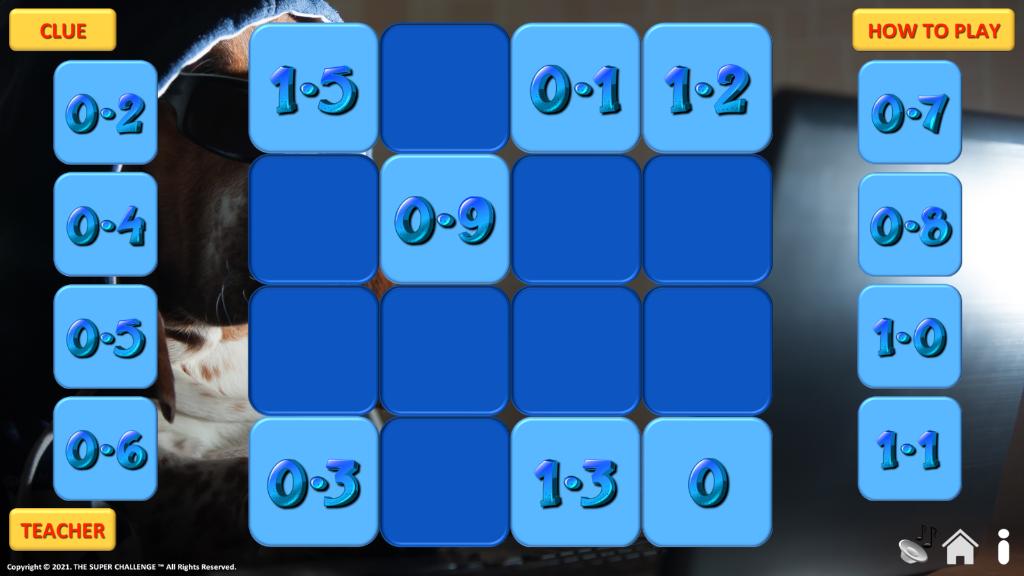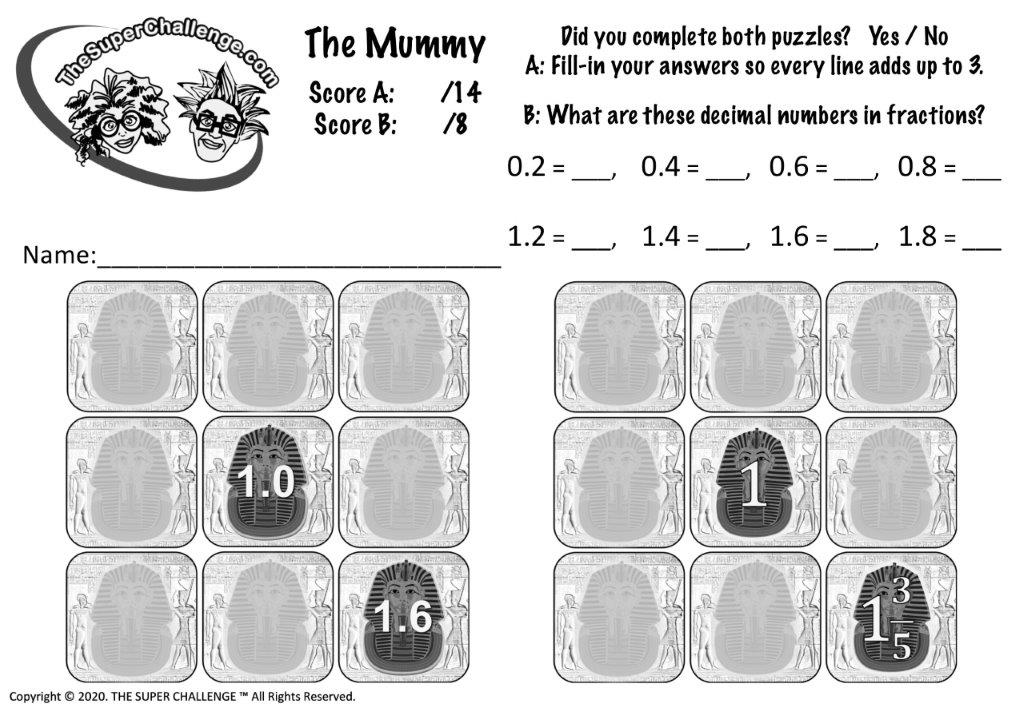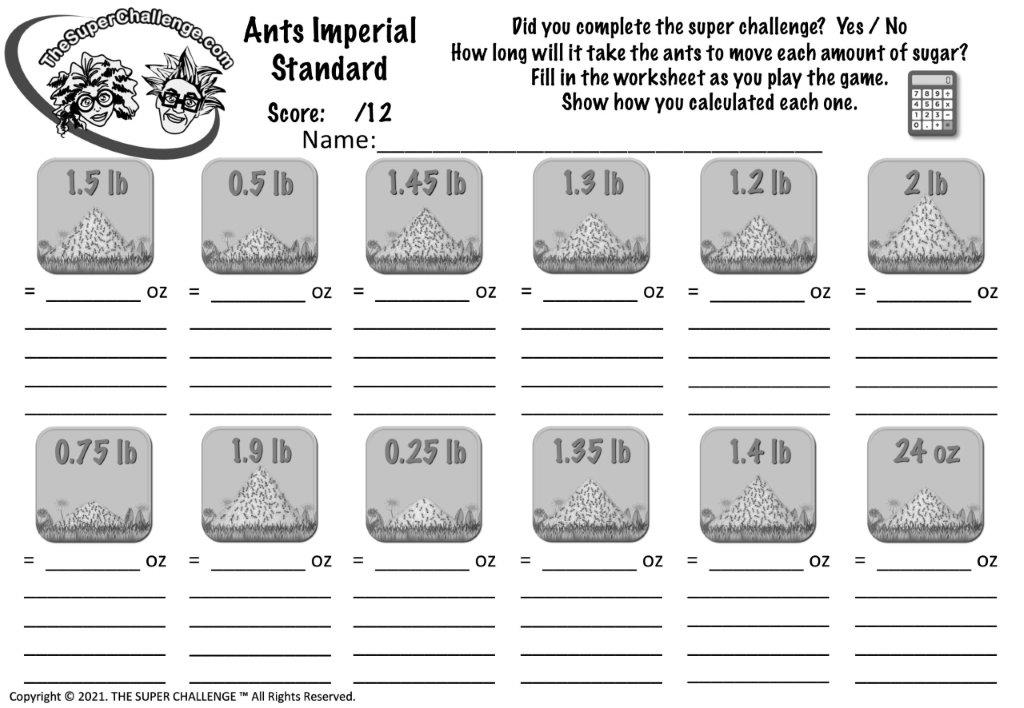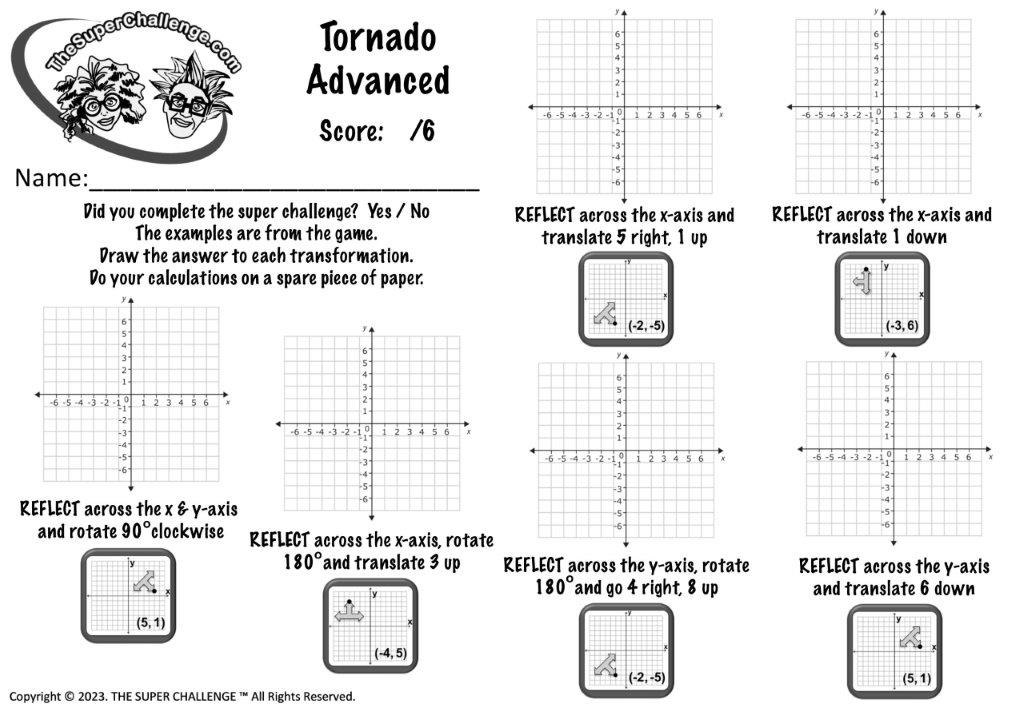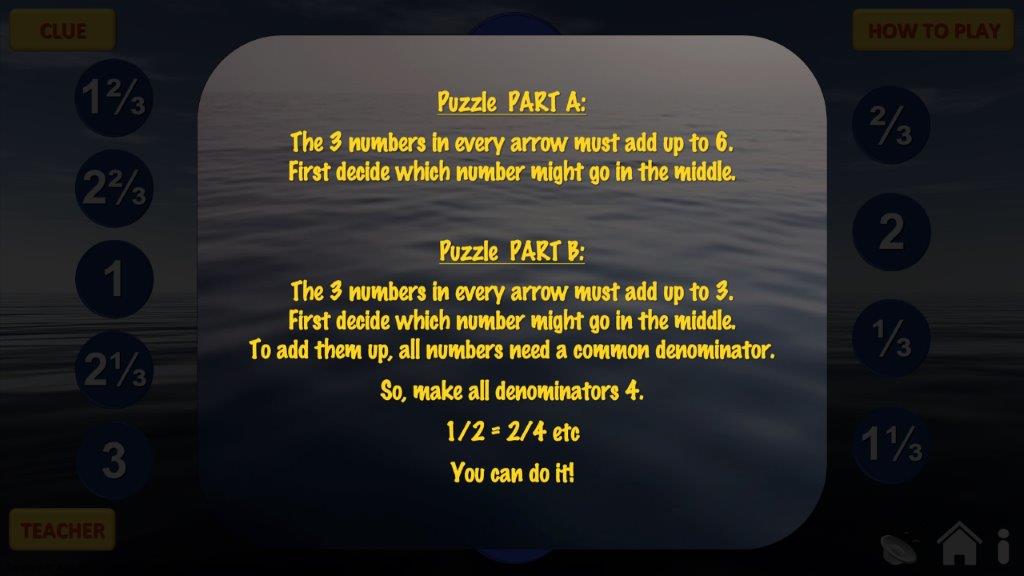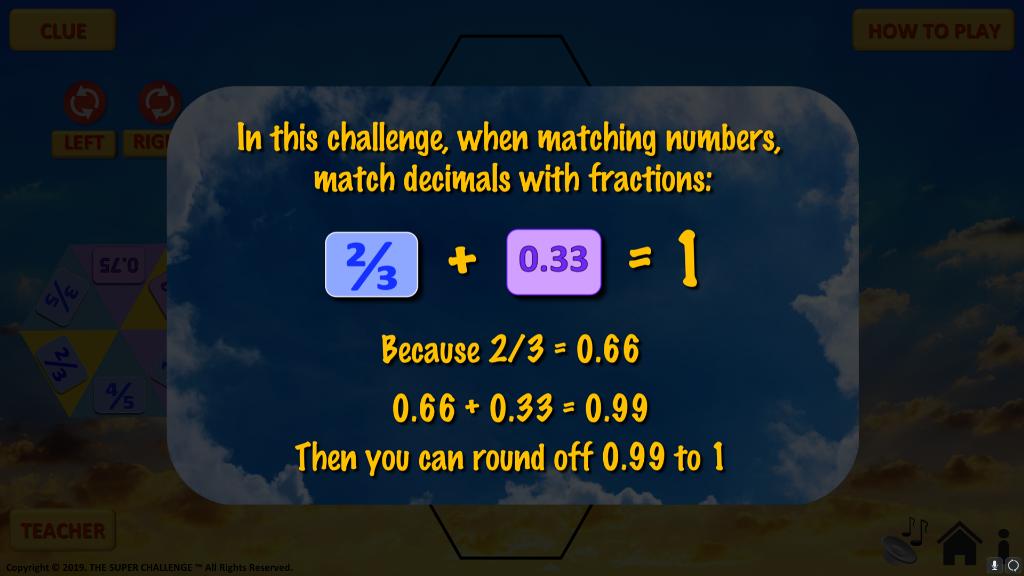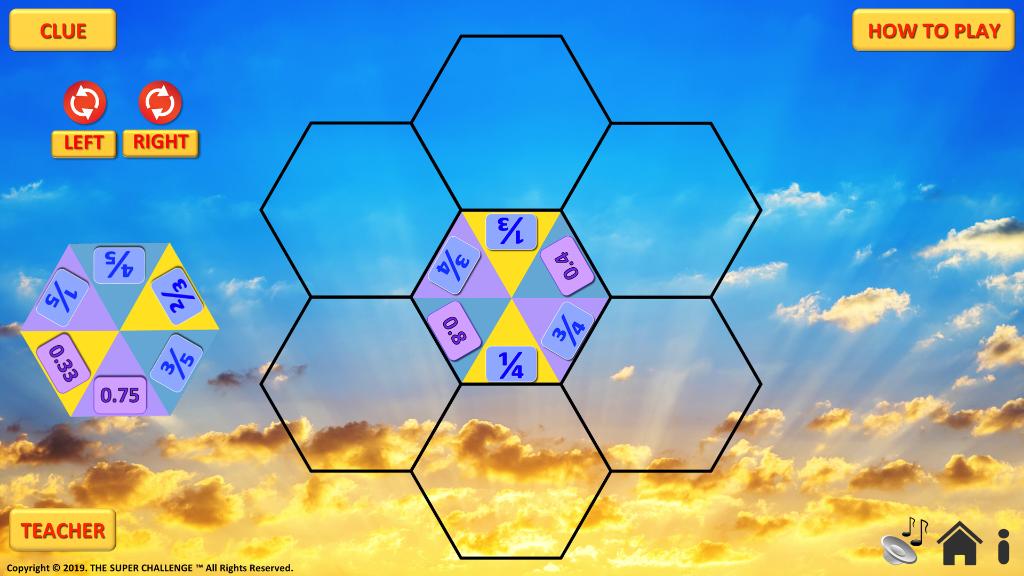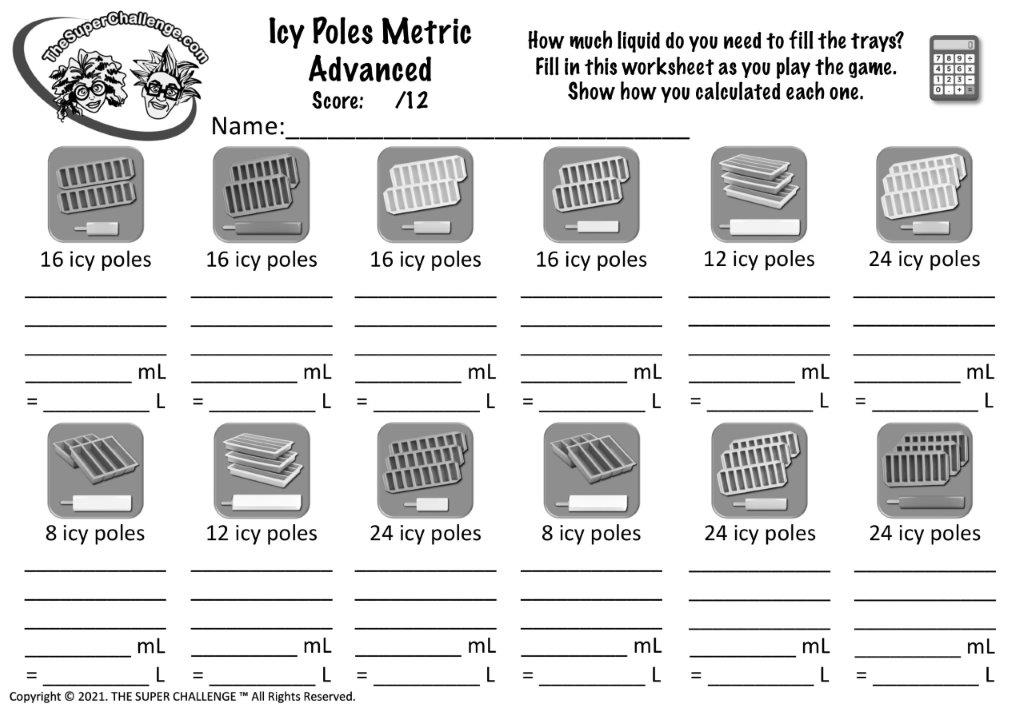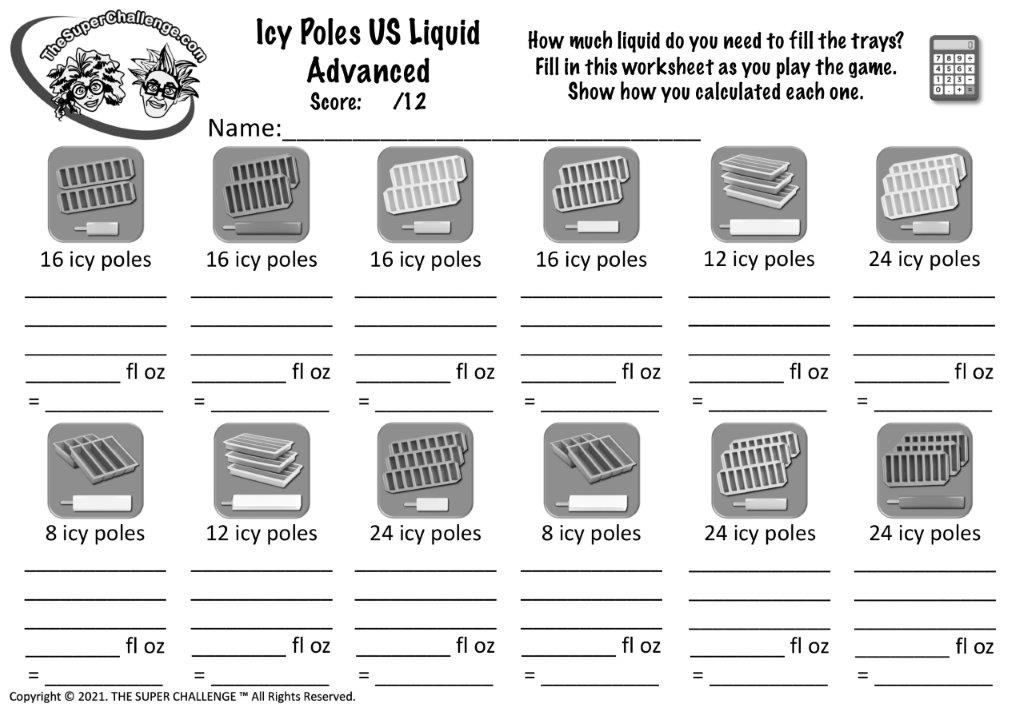YOUR SUPER CHALLENGE:
Your challenge is to complete any 5 games from YOUR grade level. You may do any combination of Mid-level or Advanced level games as long as they are of YOUR grade. A game is only completed when you finish all the questions in the game. You may try some games first to see which ones you would like to play. For games that have different versions, (Standard/Advanced, Money, Metric/Imperial etc), you only need to complete one of the versions. If you do other versions of the same game, it is still counted as only one game.
If you shut the game down, you will have to play from the start again. But if you write down your answers on the worksheet as you play, you can catch up to where you left the game. (The worksheet is optional.)
Once you have fully finished 5 different games, you have completed your challenge and may download your Certificate of Congratulations! But don’t stop there, challenge YOURSELF to see how many more games you can complete!
PARENTS & TUTORS:
The “Advanced Level” games are set at a level students aim to be at by the END of their school year. Also, games are not designed to be played on Safari browsers and may not load. All games may be played on PC’s & laptops; however, some may also be played on tablets, see the listing under each game name.
Warning: Games are not designed to be played using the Safari browsers.
Games should only be played using a web browser such as Chrome, Firefox or Microsoft Edge.
Please open this website using one of these browsers.
It is also advised you have the latest version of the Chrome, Firefox or Microsoft Edge web browsers.
Grade 6 Explained

SPENDING MONEY – AUSTRALIA
GAME PLAYS ON: PC & LAPTOP ONLY
Spending Money – Australia - Game Description
Ages: 11 – 12 years old
Suits: Grade 6 students in Australia.
How to calculate percentage discounts of 10%, 25% and 50%.
This game is designed to help students learn how to calculate percentage discounts on sale items using a calculator. Students must first work out the percentage discount, then subtract it from the original price. Shopping for discounted items is a very practical example that all students can relate to. It is a simple and clear way for students to grasp the concept of percentages.
The game is also filled with positive voice-overs to build confidence in mathematics. It is designed to suit the Mathematics Curriculum of Australia as it uses the Australian currency. It is recommended students play the other Spending Money versions to learn about other countries’ currencies.
Teacher Reference:
(ACMNA132): Investigate and calculate percentage discounts of 10%, 25% and 50% on sale items, with and without digital technologies.
Ref: Australian Curriculum Mathematics.
How To Play:
You are on a holiday and have spending money. To make your money last, you only buy discounted items. Click on one of the DISCOUNTED ITEMS. Calculate how much you paid. (See the CLUE.) Then drag the correct answer. No guessing! You must get the answer correct on your first or second try, otherwise the GAME STARTS AGAIN. Can you write down in numbers, how you did one of them? (See the worksheet.)
Spending Money – Australia - Learning Outcomes

Spending Money – Australia - Worksheet
SPENDING MONEY – CANADA
GAME PLAYS ON: PC & LAPTOP ONLY
Spending Money – Canada - Game Description
Ages: 11 – 12 years old
Suits: Sixth Grade students in Canada.
How to calculate percentage discounts of 10%, 25% and 50%.
This game is designed to help students learn how to calculate percentage discounts on sale items using a calculator. Students must first work out the percentage discount, then subtract it from the original price. Shopping for discounted items is a very practical example that all students can relate to. It is a simple and clear way for students to grasp the concept of percentages.
The game is also filled with positive voice-overs to build confidence in mathematics. It is designed to suit the Mathematics Curriculum of Canada as it uses the Canadian currency. It is recommended students play the other Spending Money versions to learn about other countries’ currencies.
Teacher Reference:
(ACMNA132): Investigate and calculate percentage discounts of 10%, 25% and 50% on sale items, with and without digital technologies.
Ref: Australian Curriculum Mathematics.
How To Play:
You are on a holiday and have spending money. To make your money last, you only buy discounted items. Click on one of the DISCOUNTED ITEMS. Calculate how much you paid. (See the CLUE.) Then drag the correct answer. No guessing! You must get the answer correct on your first or second try, otherwise the GAME STARTS AGAIN. Can you write down in numbers, how you did one of them? (See the worksheet.)
Spending Money – Canada - Learning Outcomes

Spending Money – Canada - Worksheet
SPENDING MONEY – ENGLAND
GAME PLAYS ON: PC & LAPTOP ONLY
Spending Money – England - Game Description
Ages: 11 – 12 years old
Suits: Year 7 students in England.
How to calculate percentage discounts of 10%, 25% and 50%.
This game is designed to help students learn how to calculate percentage discounts on sale items using a calculator. Students must first work out the percentage discount, then subtract it from the original price. Shopping for discounted items is a very practical example that all students can relate to. It is a simple and clear way for students to grasp the concept of percentages.
The game is also filled with positive voice-overs to build confidence in mathematics. It is designed to suit the Mathematics Curriculum of England as it uses British currency. It is recommended students play the other Spending Money versions to learn about other countries’ currencies.
Teacher Reference:
(ACMNA132): Investigate and calculate percentage discounts of 10%, 25% and 50% on sale items, with and without digital technologies.
Ref: Australian Curriculum Mathematics.
How To Play:
You are on a holiday and have spending money. To make your money last, you only buy discounted items. Click on one of the DISCOUNTED ITEMS. Calculate how much you paid. (See the CLUE.) Then drag the correct answer. No guessing! You must get the answer correct on your first or second try, otherwise the GAME STARTS AGAIN. Can you write down in numbers, how you did one of them? (See the worksheet.)
Spending Money – England - Learning Outcomes

Spending Money – England - Worksheet
SPENDING MONEY – U.S.A.
GAME PLAYS ON: PC & LAPTOP ONLY
Spending Money – U.S.A. - Game Description
Ages: 11 – 12 years old
Suits: Sixth Grade students in the U.S.A.
How to calculate percentage discounts of 10%, 25% and 50%.
This game is designed to help students learn how to calculate percentage discounts on sale items using a calculator. Students must first work out the percentage discount, then subtract it from the original price. Shopping for discounted items is a very practical example that all students can relate to. It is a simple and clear way for students to grasp the concept of percentages.
The game is also filled with positive voice-overs to build confidence in mathematics. It is designed to suit the Mathematics Curriculum of the U.S.A. as it uses U.S.A. currency. It is recommended students play the other Spending Money versions to learn about other countries’ currencies.
Teacher Reference:
(ACMNA132): Investigate and calculate percentage discounts of 10%, 25% and 50% on sale items, with and without digital technologies.
Ref: Australian Curriculum Mathematics.
How To Play:
You are on a holiday and have spending money. To make your money last, you only buy discounted items. Click on one of the DISCOUNTED ITEMS. Calculate how much you paid. (See the CLUE.) Then drag the correct answer. No guessing! You must get the answer correct on your first or second try, otherwise the GAME STARTS AGAIN. Can you write down in numbers, how you did one of them? (See the worksheet.
Spending Money – U.S.A. - Learning Outcomes

Spending Money – U.S.A. - Worksheet
TULIP FARM – STANDARD
GAME PLAYS ON: PC & LAPTOP ONLY
Tulip Farm – Standard - Game Description
Ages: 11 – 12 years old
Suits: Grade 6 students in Australia, Sixth Grade students in the U.S.A. & Canada and Year 7 students in England.
Introducing the four quadrants of the Cartesian coordinate system & ordered pairs.
Helping students learn about the Cartesian coordinate system using all four quadrants. Students are given examples of graphs with four quadrants. Each example has a section marked that represents rows of tulips to be watered. Students must then choose the correct set of ordered pairs to ensure the flowers are watered by a satellite sprinkler system. It is a very practical and simple way for them to learn the Cartesian coordinate system and ordered pairs.
Full of satellite sounds it is a very engaging game to play. It is designed to suit the Mathematics Curriculums of Australia, Canada, England and the U.S.A.
Teacher Reference:
(ACMMG143): Introduce the Cartesian coordinate system using all four quadrants.
Ref: Australian Curriculum Mathematics.
How To Play:
During the school holidays you work on a tulip farm. You oversee the sprinklers. The program you use to water the flowers is a satellite system. The areas to water are located on graphs. Click on one of the graphs. Choose the correct set of coordinates to match it. Then drag your answer to the graph above. Get it right and the flowers thrive. Get it wrong and the flowers wither!
Tulip Farm – Standard - Learning Outcomes

Tulip Farm – Standard - Worksheet
TULIP FARM – ADVANCED
GAME PLAYS ON: PC & LAPTOP ONLY
Tulip Farm – Advanced - Game Description
Ages: 11 – 12 years old
Suits: Grade 6 students in Australia, Sixth Grade students in the U.S.A. & Canada and Year 7 students in England.
Advanced use of the four quadrants of the Cartesian coordinate system & ordered pairs.
This is the more challenging version of the game Tulip Farm – Standard. In this game students must work harder to achieve results. The examples given are more complex. It is an excellent game for teachers to gauge if a student fully understands the cartesian coordinate system. Although challenging, it is still within this age groups capabilities.
Full of satellite sounds it is a very engaging game to play. It is designed to suit the Mathematics Curriculums of Australia, Canada, England and the U.S.A.
Teacher References:
(ACMMG143): Introduce the Cartesian coordinate system using all four quadrants. Understanding that the Cartesian plane provides a graphical or visual way of describing location.
Ref: Australian Curriculum Mathematics.
How To Play:
You must reset the sprinkler program for your tea farm. The program you use to water the crop is a satellite system. The areas to water are located on graphs. Last time you did this your PC did not enlarge the graphs! This time it is not showing the reference numbers on each graph. Once again you will have to judge which graph is correct. Click on one of the sets of coordinates. Choose the correct graph to match it. Then DRAG your answer to the coordinates above. It’s a challenge but you can do it!
Tulip Farm – Advanced - Learning Outcomes

Tulip Farm – Advanced - Worksheet
MISSING AREA – METRIC
GAME PLAYS ON: PC, LAPTOP & TABLET
Missing Area – Metric - Game Description
Ages: 11 – 12 years old
Suits: Grade 6 students in Australia and Sixth Grade students in Canada.
Problem-solving involving calculations of area and perimeter.
This is a great game to develop problem-solving skills. Students must perform area and perimeter calculations to solve a challenging puzzle. They must first complete a tangram challenge, then they must find the missing area of part of the completed shape.
Having two parts to the puzzle keeps students engaged and makes the game lots of fun. The second part of the game involves many calculations, making it a good exercise in arithmetic. The game is used by teachers as a good gauge on how confident a student is with problem solving. Designed to suit the Mathematics Curriculums of Australia and Canada as it uses the metric system.
Teacher Reference:
(ACMMG137): Solve problems involving the comparison of lengths and areas using appropriate units.
Ref: Australian Curriculum Mathematics.
How To Play:
Use the blue shapes to fill the yellow square. DRAG the shapes to move them. Then you can FLIP or TURN each one to fit. If you can do it, your super challenge will appear. You have to find the AREA & PERIMETER of the yellow rectangle. Put your thinking cap on! Don’t give up, you can do it!
Missing Area – Metric - Learning Outcomes

Missing Area – Metric - Worksheet
MISSING AREA – IMPERIAL
GAME PLAYS ON: PC, LAPTOP & TABLET
Missing Area – Imperial - Game Description
Ages: 11 – 12 years old
Suits: Sixth Grade students in the U.S.A. and Year 7 students in England.
Problem-solving involving calculations of area and perimeter.
This is a great game to develop problem-solving skills. Students must perform area and perimeter calculations to solve a challenging puzzle. They must first complete a tangram challenge, then they must find the missing area of part of the completed shape.
Having two parts to the puzzle keeps students engaged and makes the game lots of fun. The second part of the game involves many calculations, making it a good exercise in arithmetic. The game is used by teachers as a good gauge on how confident a student is with problem solving. Designed to suit the Mathematics Curriculums of the U.S.A. and England as it uses the imperial system.
Teacher Reference:
(ACMMG137): Solve problems involving the comparison of lengths and areas using appropriate units.
Ref: Australian Curriculum Mathematics.
How To Play:
Use the blue shapes to fill the yellow square. DRAG the shapes to move them. Then you can FLIP or TURN each one to fit. If you can do it, your super challenge will appear. You have to find the AREA & PERIMETER of the yellow rectangle. Put your thinking cap on! Don’t give up, you can do it!
Missing Area – Imperial - Learning Outcomes

Missing Area – Imperial - Worksheet
WINDOWS – STANDARD
GAME PLAYS ON: PC & LAPTOP ONLY
Windows – Standard - Game Description
Ages: 11 – 12 years old
Suits: Grade 6 students in Australia, Sixth Grade students in the U.S.A. & Canada and Year 7 students in England.
Adding, multiplying, subtracting and dividing decimals and fractions.
This is an engaging problem-solving game using decimals and fractions of thirds, quarters, sixths and eighths. It involves all four operations with fractions of related denominators. Students must add, multiply, subtract and divide decimals and fractions.
It is an excellent game to develop a good understanding of working with decimals and fractions. Whilst it has many mathematical learning benefits, it is still lots of fun to play. There are four levels to the game catering for the beginner to the more proficient student. It is designed to suit the Mathematics Curriculums of Australia, Canada, England and the U.S.A.
Teacher References:
(ACMNA123): Solve problems involving all four operations with whole numbers.
(ACMNA126): Solve problems involving addition and subtraction (multiplication & division) of fractions with the same or related denominators.
(ACMNA128): Add and subtract decimals, without digital technologies.
(ACMNA129): Multiply decimals by whole numbers and perform divisions by whole numbers without digital technologies.
Ref: Australian Curriculum Mathematics.
How To Play:
Put numbers into the windows so all number sentences are correct! You must not put numbers into windows that have the symbols: + − × ÷ = There are two ways to solve each puzzle. Once completed, play the game again and find the other solutions!
Windows – Standard - Learning Outcomes

Windows – Standard - Worksheet
WINDOWS – ADVANCED
GAME PLAYS ON: PC & LAPTOP ONLY
Windows – Advanced - Game Description
Ages: 11 – 12 years old
Suits: Grade 6 students in Australia, Sixth Grade students in the U.S.A. & Canada and Year 7 students in England.
More complex addition, multiplication, subtraction and division of decimals and fractions.
This is the more challenging version of the Windows – Standard game. More complex number sentence skills are needed. The game involves all four operations with fractions of related denominators. Students must add, multiply, subtract and divide decimals and fractions.
It is an excellent game to develop a good understanding of working with decimals and fractions. Whilst it is more of a challenge for students, it is still within their capabilities. It is designed to suit the Mathematics Curriculums of Australia, Canada, England and the U.S.A.
Teacher References:
(ACMNA123): Solve problems involving all four operations with whole numbers.
(ACMNA126): Solve problems involving addition and subtraction (multiplication & division) of fractions with the same or related denominators.
(ACMNA128): Add and subtract decimals, without digital technologies.
(ACMNA129): Multiply decimals by whole numbers and perform divisions by whole numbers without digital technologies.
Ref: Australian Curriculum Mathematics.
How To Play:
Put numbers into the windows so all number sentences are correct! You must not put numbers into windows that have the symbols: + − × ÷ = There are two ways to solve each puzzle. Once completed, play the game again and find the other solutions!
Windows – Advanced - Learning Outcomes
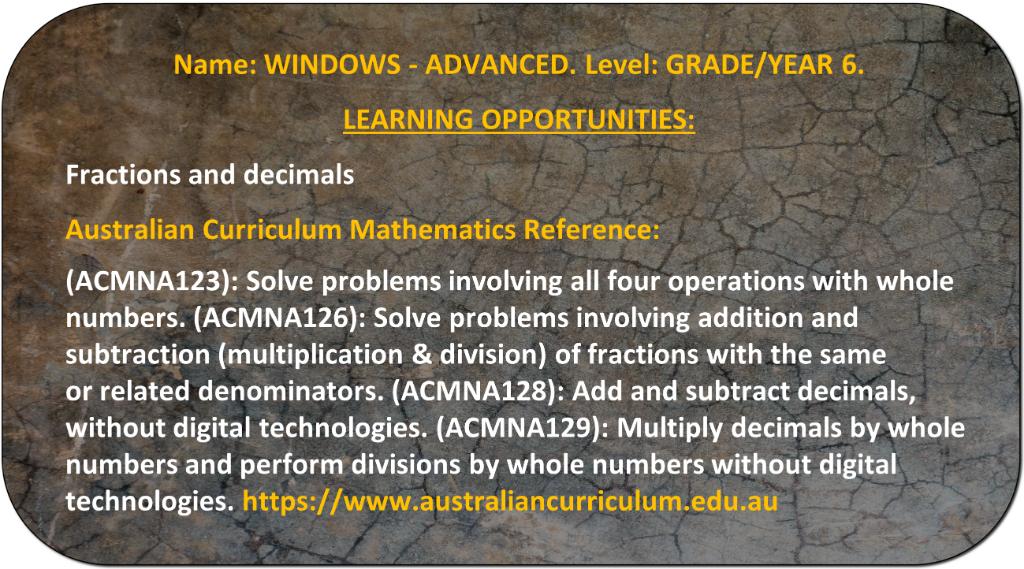
Windows – Advanced - Worksheet
HONEY – METRIC STANDARD
GAME PLAYS ON: PC & LAPTOP ONLY
Honey – Metric Standard - Game Description
Ages: 11 – 12 years old
Suits: Grade 6 students in Australia and Sixth Grade students in Canada.
Multiply and divide decimals by whole numbers.
Students are given the task of calculating how many trips bees must make to produce honey to fill different sized jars. The game also helps students to become more proficient with problem-solving.
It is fun to play and full of sounds of nature and positive voice-overs to build students confidence with mathematics and problem-solving. This game is designed to suit the Mathematics Curriculums of Australia and Canada.
Teacher References:
(ACMNA129): Multiply decimals by whole numbers and perform divisions by non-zero whole numbers where the results are terminating decimals, with and without digital technologies.
(ACMMG136): Convert between common metric units of mass. Identifying and using the correct operations when converting units
Ref: Australian Curriculum Mathematics.
How To Play:
Bees are collecting nectar by flying to a flower and back to the hive, one trip. Each trip produces 0.02 grams of honey. What is the total number of trips bees must travel to fill each jar? (See the CLUE.) Choose one of the jars and click on it. Then choose your answer and drag it to the jar. Your challenge is to complete the game! You can do it!
Honey – Metric Standard - Learning Outcomes

Honey – Metric Standard - Worksheet
HONEY – IMPERIAL STANDARD
GAME PLAYS ON: PC & LAPTOP ONLY
Honey – Imperial Standard - Game Description
Ages: 11 – 12 years old
Suits: Grade 6 students in the U.S.A. and Year 7 students in England.
Multiply and divide decimals by whole numbers.
Students are given the task of calculating how many trips bees must make to produce honey to fill different sized jars. The game also helps students to become more proficient with problem-solving.
It is fun to play and full of sounds of nature and positive voice-overs to build students confidence with mathematics and problem-solving. This game is designed to suit the Mathematics Curriculums of England and the U.S.A.
Teacher References:
(ACMNA129): Multiply decimals by whole numbers and perform divisions by non-zero whole numbers where the results are terminating decimals, with and without digital technologies.
(ACMMG136): Convert between common units of mass. Identifying and using the correct operations when converting units.
Ref: Australian Curriculum Mathematics.
How To Play:
Bees are collecting nectar by flying to a flower and back to the hive, one trip. Each trip produces 0.01 ounces of honey. What is the total number of trips bees must travel to fill each jar? (See the CLUE.) Choose one of the jars and click on it. Then choose your answer and drag it to the jar. Your challenge is to complete the game! You can do it!
Honey – Imperial Standard - Learning Outcomes
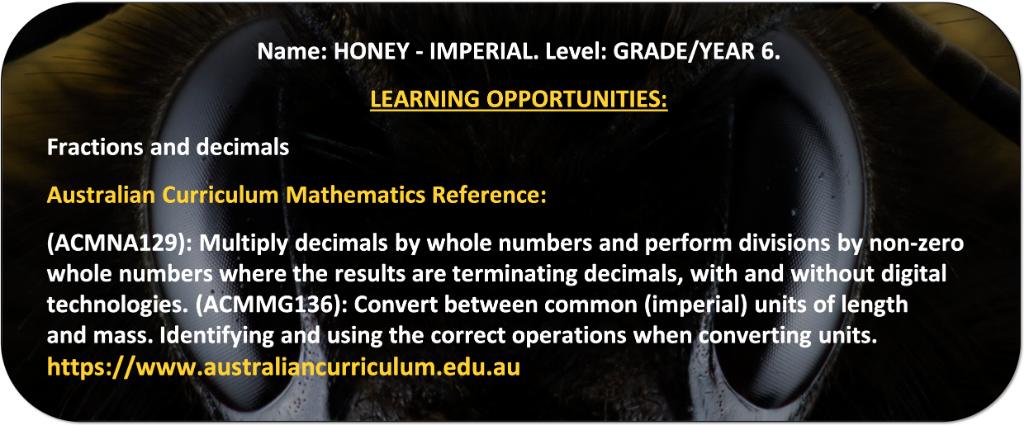
Honey – Imperial Standard - Worksheet
HONEY – METRIC ADVANCED
GAME PLAYS ON: PC & LAPTOP ONLY
Honey – Metric Advanced - Game Description
Ages: 11 – 12 years old
Suits: Grade 6 students in Australia and Sixth Grade students in Canada.
Note: This game is at an advanced level and is optional for students. It is designed to be played with teacher, tutor or parent assistance.
Multiply and divide decimals by whole numbers with advanced problem solving.
This is the more challenging version of the Honey games. It involves more complex multiplication and division of decimals by whole numbers. It also has additional benefits, such as the conversion of units of length and mass. Students recognise the equivalence of measurements, such as 1 kg = 1000 g & 1 km = 1000 m. The game also helps students to become more proficient with problem-solving.
Students are given the task of calculating how far bees must travel to collect nectar and produce honey to fill different sized jars. It is an extension of the standard honey game, involving more calculations. It is challenging yet fun to play and full of sounds of nature and positive voice-overs to build students confidence with mathematics and problem-solving. This game is designed to suit the Mathematics Curriculums of Australia and Canada.
Teacher Reference:
(ACMNA129): Multiply decimals by whole numbers.
(This game also includes division of whole numbers by decimals.)
Identifying and using the correct operations when converting units. Proficiency with problem-solving using a calculator.
Ref: Australian Curriculum Mathematics.
How To Play:
Bees are collecting nectar by flying to a flower and back to the hive, one trip. Each trip produces 0.02 grams of honey. What is the total distance bees must travel to fill each jar? (See the CLUE.) Choose one of the jars and click on it. Then choose your answer and drag it to the jar. No guessing! You must get the answer correct on your first or second try, otherwise the GAME STARTS AGAIN! Your challenge is to complete the game! You can do it!
Honey – Metric Advanced - Learning Outcomes

Honey – Metric Advanced - Worksheet
HONEY – IMPERIAL ADVANCED
GAME PLAYS ON: PC & LAPTOP ONLY
Honey – Imperial Advanced - Game Description
Ages: 11 – 12 years old
Suits: Grade 6 students in the U.S.A. and Year 7 students in England.
Note: This game is at an advanced level and is optional for students. It is designed to be played with teacher, tutor or parent assistance.
Multiply and divide decimals by whole numbers with advanced problem solving.
This is the more challenging version of the Honey games. It involves more complex multiplication and division of decimals by whole numbers. It also has additional benefits, such as the conversion of units of length and mass. Students recognize/recognize the equivalence of measurements, such as 1 pound (lb) = 16 ounces (oz), 1 mile (mi) = 1760 yards (yd) = 5280 feet (ft). The game also helps students to become more proficient with problem-solving.
Students are given the task of calculating how far bees must travel to collect nectar and produce honey to fill different sized jars. It is an extension of the standard honey game, involving more calculations. It is challenging yet fun to play and full of sounds of nature and positive voice-overs to build students confidence with mathematics and problem-solving. This game is designed to suit the Mathematics Curriculums of England and the U.S.A.
Teacher Reference:
(ACMNA129): Multiply decimals by whole numbers.
(This game also includes division of whole numbers by decimals.)
Recognising/recognizing the equivalence of measurements….
Identifying and using the correct operations when converting units…
Ref: Australian Curriculum Mathematics.
How To Play:
Bees are collecting nectar by flying to a flower and back to the hive, one trip. Each trip produces 0.01 ounces of honey. What is the total distance bees must travel to fill each jar? (See the CLUE.) Choose one of the jars and click on it. Then choose your answer and drag it to the jar. No guessing! You must get the answer correct on your first or second try, otherwise the GAME STARTS AGAIN! Your challenge is to complete the game! You can do it!
Honey – Imperial Advanced - Learning Outcomes

Honey – Imperial Advanced - Worksheet
PYRAMIDS AND PRISMS
GAME PLAYS ON: PC & LAPTOP ONLY
Pyramids and Prisms - Game Description
Ages: 11 – 12 years old
Suits: Grade 6 students in Australia, Sixth Grade students in the U.S.A. & Canada and Year 7 students in England.
Connecting three-dimensional objects with their nets and constructing simple prisms and pyramids.
This game helps students learn about nets of three-dimensional objects.
Set in the year 40BC in Egypt, at the time of queen Cleopatra, the game is also culturally educational. It is filled with Middle Eastern sound effects and music, making it lots of fun and very engaging. It becomes more and more challenging as it is played and is a good gauge for teachers to see how well a student grasps the concept. Designed to suit the Mathematics Curriculums of Australia, Canada, England and the U.S.A.
Teacher References:
(ACMMG140): Construct simple prisms and pyramids.
(ACMMG111): Connect three-dimensional objects with their nets and other two-dimensional representations.
Ref: Australian Curriculum Mathematics.
How To Play:
The year is 40BC and Queen Cleopatra has asked you to help her build a temple. So, you had better know your 3D shapes! Click on a shape. Choose the correct NET. (A NET can be folded to make a 3D shape.) Then drag it to the shape to see if you are correct. No guessing! You must get the answer correct your first or second try, otherwise the GAME STARTS AGAIN! To complete your challenge: Can you make one of the shapes out of paper? (See the worksheet.)
Pyramids and Prisms - Learning Outcomes

Pyramids and Prisms - Worksheet
UNDERCOVER
GAME PLAYS ON: PC, LAPTOP & TABLET
Undercover - Game Description
Ages: 11 – 12 years old
Suits: Grade 6 students in Australia, Sixth Grade students in the U.S.A. & Canada and Year 7 students in England.
Helping students to become proficient at adding and subtracting decimals, without the use of a calculator.
This game gives students a good understanding of addition and subtraction computations involving decimals. The challenge is for students to stop a computer virus that threatens the world. Students must complete two challenging number puzzles without a calculator.
The game is filled with undercover/spy sounds creating an exciting atmosphere that keeps students engaged and is lots of fun to play. This game designed to suit the Mathematics Curriculums of Australia, Canada, England and the U.S.A.
Teacher Reference:
(ACMNA128): Add and subtract decimals, with and without digital technologies. Extending whole-number strategies to explore and develop meaningful written strategies for addition and subtraction of decimal numbers.
Ref: Australian Curriculum Mathematics.
How To Play:
You are a secret agent undercover! Your mission is to stop a computer virus. First you must break a secret computer code. Once you find the code you will be able to stop the virus. The uncompleted code will appear. By solving both puzzles, you find the code and stop the virus. Then your mission will be completed! See the CLUE to break the code. Good luck, the world is depending on you!
Undercover - Learning Outcomes

Undercover - Worksheet
SAME SAME – STANDARD
GAME PLAYS ON: PC & LAPTOP ONLY
Same Same – Standard - Game Description
Ages: 11 – 12 years old
Suits: Grade 6 students in Australia, Sixth Grade students in the U.S.A. & Canada and Year 7 students in England.
Calculating the probability of outcomes.
This game helps students understand probability. Students must describe chance outcomes using fractions. This game is a simple and clear way for students to grasp the concept. Each challenge includes an easy to understand diagram on how to do each calculation.
Students must calculate the probability of pulling out the same colour / color gumball in each hand, from two jars. It is very engaging and lots of fun for students to play. This game is designed to suit the Mathematics Curriculums of Australia, Canada, England and the U.S.A.
Teacher References:
(ACMSP114): Describe probabilities using fractions, decimals and percentages.
(ACMSP146): Compare observed frequencies across experiments with expected frequencies. Predicting likely outcomes from a run of chance events and distinguishing these from surprising results.
Ref: Australian Curriculum Mathematics.
How To Play:
Do you know how to work out the chances of something happening? Here is your challenge: Can you work out the chances of pulling out the same colour / color gumball in each hand? Choose one of the sets of jars. Imagine you put a hand in each jar at the same time. Then you mix the gumballs up and without looking, you pull out 1 gumball in each hand. What is the chance of getting the same colour / color? Click on one of the sets of jars. Only one of the 4 given is correct! Which one is it?
Same Same – Standard - Learning Outcomes

Same Same – Standard - Worksheet
SAME SAME – ADVANCED
GAME PLAYS ON: PC & LAPTOP ONLY
Same Same – Advanced - Game Description
Ages: 11 – 12 years old
Suits: Grade 6 students in Australia, Sixth Grade students in the U.S.A. & Canada and Year 7 students in England.
More advanced calculations of the probability of outcomes.
This is the more challenging version of the game Same Same – Standard. In this game students must work harder to achieve results. The examples given are more complex. It is an excellent game for teachers to gauge if a student fully understands probability. Although challenging, it is still within this age groups capabilities.
This game is designed to suit the Mathematics Curriculums of Australia, Canada, England and the U.S.A.
Teacher References:
(ACMSP114): Describe probabilities using fractions, decimals and percentages.
(ACMSP146): Compare observed frequencies across experiments with expected frequencies. Predicting likely outcomes from a run of chance events and distinguishing these from surprising results.
Ref: Australian Curriculum Mathematics.
How To Play:
Are you ready for the more challenging version of this game?
Same Rules: Choose one of the sets of jars. Imagine you put a hand in each jar at the same time. Then you mix the gumballs up and without looking, you pull out 1 gumball in each hand. What is the chance of getting the same colour / color in each hand?
Click on one of the sets of jars. Only one of the 4 choices given is correct! Choose your answer and DRAG it to the jars. (See the CLUE.)
Same Same – Advanced - Learning Outcomes

Same Same – Advanced - Worksheet
THE MUMMY
GAME PLAYS ON: PC, LAPTOP & TABLET
The Mummy - Game Description
Ages: 11 – 12 years old
Suits: Grade 6 students in Australia, Sixth Grade students in the U.S.A. & Canada and Year 7 students in England.
Adding fractions & adding decimals, without a calculator.
This is a fun game helping students to solve problems involving addition of fractions and addition of decimals. The game has a dual benefit as it explores operations with both fractions and with decimals and without a calculator. Addition of fractions and decimals can be difficult concepts to grasp for this age group. This game presents both concepts in a very simple and engaging way as students must solve a challenging 3×3 grid puzzle.
Set in the Eastern Desert and full of fascinating sounds and Egyptian music, it is a very engaging and fun game to play. It is designed to suit the Mathematics Curriculums of Australia, Canada, England and the U.S.A.
Teacher References:
(ACMNA128): Add decimals, without digital technologies. Exploring and practising efficient methods for solving problems requiring operations on decimals, to gain fluency with calculating with decimals.
(ACMNA126): Solve problems involving addition of fractions with the same or related denominators.
Ref: Australian Curriculum Mathematics.
How To Play:
You have accidentally disturbed an ancient mummy in the Eastern Desert! A curse has been placed upon you! You need to complete the puzzle to lift the curse. Put numbers into the grid so every line will add up to 3. See the CLUE for help! Once you complete this challenge, the curse will be lifted! Good luck!
The Mummy - Learning Outcomes

The Mummy - Worksheet
WHAT’S YOUR ANGLE – STANDARD
GAME PLAYS ON: PC & LAPTOP ONLY
What’s Your Angle – Standard - Game Description
Ages: 11 – 12 years old
Suits: Grade 6 students in Australia, Sixth Grade students in the U.S.A. & Canada and Year 7 students in England.
Learning reflections and rotations of angles up to 360 degrees.
This game investigates reflections and rotations of angles. It helps students learn that translations, rotations, and reflections can change the position and orientation but not shape or size of an object. It also has a double benefit as it used angles in the examples, giving students a good understanding of angles up to 360 degrees.
Set on a spacecraft in orbit, it is full of fascinating outer space sounds making it very engaging and fun to play. Students must reflect, and rotate angles as instructed to save a fellow astronaut who is lost in space. This game is designed to suit the Mathematics Curriculums of Australia, Canada, England and the U.S.A.
Teacher Reference:
(ACMMG142): Investigate combinations of reflections and rotations, with and without the use of digital technologies.
Ref: Australian Curriculum Mathematics.
How To Play:
You are the commander of a spacecraft. One of your astronauts is lost in space! Can you help them with directions back to the spacecraft? Click on an ANGLE and follow the directions. Only one of the four answers given is correct. Choose the correct answer, see the CLUE. Then drag your answer to the ANGLE above. Once you have completed the challenge, your astronaut will be saved. Will you save them?
What’s Your Angle – Standard - Learning Outcomes

What’s Your Angle – Standard - Worksheet
WHAT’S YOUR ANGLE – ADVANCED
GAME PLAYS ON: PC & LAPTOP ONLY
What’s Your Angle – Advanced - Game Description
Ages: 11 – 12 years old
Suits: Grade 6 students in Australia, Sixth Grade students in the U.S.A. & Canada and Year 7 students in England.
Advanced reflections and rotations of angles up to 360 degrees.
This is the more challenging version of the game What’s Your Angle – Standard. In this game students must work harder as the examples given are more complex. It is an excellent game for teachers to gauge if a student fully understands reflections, rotations and angles. Although challenging, it is still within this age groups capabilities.
This game is designed to suit the Mathematics Curriculums of Australia, Canada, England and the U.S.A.
Teacher Reference:
(ACMMG142): Investigate combinations of reflections and rotations, with and without the use of digital technologies.
Ref: Australian Curriculum Mathematics.
How To Play:
You have successfully helped your astronaut back to the spacecraft. Now you are on a spacewalk to repair equipment. You must get every direction correct or you may be thrown into outer space! Click on an ANGLE and follow the directions.
Only one of the four answers given is correct. Choose the correct answer, see the CLUE. Then DRAG your answer to the ANGLE above. Are you ready for the challenge? You can do it!
What’s Your Angle – Advanced - Learning Outcomes
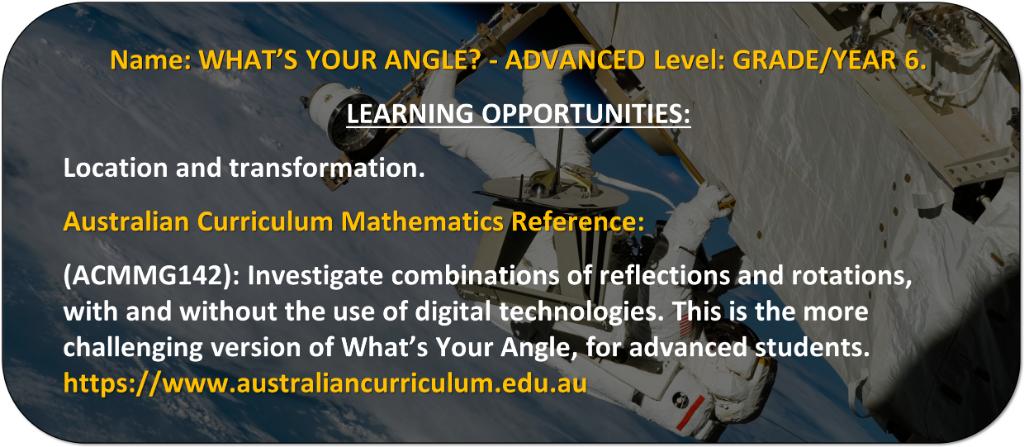
What’s Your Angle – Advanced - Worksheet
SCENIC FLIGHT – METRIC STANDARD
GAME PLAYS ON: PC & LAPTOP ONLY
Scenic Flight – Metric Standard - Game Description
Ages: 11 – 12 years old
Suits: Grade 6 students in Australia & Canada.
Problem-solving using metric units of measurement.
This game is designed to help students become proficient at problem-solving using metric units of measurement. It also has additional benefits, such as the conversion of metric units, i.e., L to mL and connecting decimal representations to the metric system.
Students are given the task of calculating how far they can fly in a small airplane with varying amounts of fuel. It is full of learning opportunities and is very rewarding and engaging to play. This game is designed to suit the Mathematics Curriculum of Australia & Canada.
Teacher References:
Becoming proficient in advanced problem solving with metric units of measurement using a calculator.
(ACMNA129): Multiply decimals by whole numbers and perform divisions by non-zero whole numbers where the results are terminating decimals, with and without digital technologies.
(ACMMG135): Connect decimal representations to the metric system.
(ACMMG136): Convert between common metric units…(L to mL).
Ref: Australian Curriculum Mathematics.
How To Play:
You are a pilot and take your dog on a scenic flight. First you must work out how far you can fly with the amount of fuel you have. Click on any of the fuel gauges. Only one of the four distances you are given is correct. Which one is it? Choose the correct answer, see the CLUE. Then drag your answer to the amount of fuel above.
Scenic Flight – Metric Standard - Learning Outcomes

Scenic Flight – Metric Standard - Worksheet
SCENIC FLIGHT – IMPERIAL STANDARD
GAME PLAYS ON: PC & LAPTOP ONLY
Scenic Flight – Imperial Standard - Game Description
Ages: 11 – 12 years old
Suits: Year 7 students in England.
Problem-solving using imperial units, students in England.
This game is designed to help students become proficient at problem-solving using imperial units of measurement. It also has additional benefits, such as the conversion of imperial units, i.e., gallons to fluid ounces, and connecting decimal representations to the imperial system.
Students are given the task of calculating how far they can fly in a small airplane with varying amounts of fuel. It is full of learning opportunities and is very rewarding and engaging to play. This game is designed to suit the Mathematics Curriculum of England.
Teacher References:
Becoming proficient in advanced problem-solving with imperial units of measurement using a calculator.
(ACMNA129): Multiply decimals by whole numbers and perform divisions by non-zero whole numbers where the results are terminating decimals, with and without digital technologies.
(ACMMG135): Connect decimal representations to the (imperial) system.
(ACMMG136): Convert between common (imperial) units…(gal to fl oz).
Ref: Australian Curriculum Mathematics.
How To Play:
You are a pilot and take your dog on a scenic flight. First you must work out how far you can fly with the amount of fuel you have. Click on any of the fuel gauges. Only one of the four distances you are given is correct. Which one is it? Choose the correct answer, see the CLUE. Then drag your answer to the amount of fuel above.
Scenic Flight – Imperial Standard - Learning Outcomes

Scenic Flight – Imperial Standard - Worksheet
SCENIC FLIGHT – US STANDARD
GAME PLAYS ON: PC & LAPTOP ONLY
Scenic Flight – US Standard - Game Description
Ages: 11 – 12 years old
Suits: Grade 6 students in the U.S.A.
Problem-solving using US Liquid units of measurement, for students in the U.S.A.
This game is designed to help students become proficient at problem-solving using US Liquid units of measurement. It also has additional benefits, such as the conversion of US Liquid units, i.e., gallons to fluid ounces and connecting decimal representations to the US system.
Students are given the task of calculating how far they can fly in a small airplane with varying amounts of fuel. It is full of learning opportunities and is very rewarding and engaging to play. This game is designed to suit the Mathematics Curriculum of the U.S.A.
Teacher References:
Becoming proficient in advanced problem-solving with US units of measurement using a calculator.
(ACMNA129): Multiply decimals by whole numbers and perform divisions by non-zero whole numbers where the results are terminating decimals, with and without digital technologies.
(ACMMG135): Connect decimal representations to the (US imperial) system.
(ACMMG136): Convert between common (US imperial) units…(gal to fl oz).
Ref: Australian Curriculum Mathematics.
How To Play:
You are a pilot and take your dog on a scenic flight. First you must work out how far you can fly with the amount of fuel you have. Click on any of the fuel gauges. Only one of the four distances you are given is correct. Which one is it? Choose the correct answer, see the CLUE. Then drag your answer to the amount of fuel challenge is to complete the game! You can do it!
Scenic Flight – US Standard - Learning Outcomes

Scenic Flight – US Standard - Worksheet
SCENIC FLIGHT – METRIC ADVANCED
GAME PLAYS ON: PC & LAPTOP ONLY
Scenic Flight – Metric Advanced - Game Description
Ages: 11 – 12 years old
Suits: Grade 6 students in Australia & Canada.
Note: This game is at an advanced level and is optional for students. It is designed to be played with teacher, tutor or parent assistance.
Advanced problem-solving using metric units of measurement.
This game is designed to help students become proficient at advanced problem-solving using metric units of measurement. It also has additional benefits, such as the conversion of metric units, i.e., L to mL and connecting decimal representations to the metric system.
Students are given the task of calculating how far they can fly in a small airplane with varying amounts of fuel. It is full of learning opportunities and is very rewarding and engaging to play. This game is designed to suit the Mathematics Curriculum of Australia & Canada.
Teacher References:
Becoming proficient in advanced problem solving with metric units of measurement using a calculator.
(ACMMG136): Convert between common metric units. Identifying and using the correct operations when converting units.
(ACMMG135): Connect decimal representations to the metric system.
Ref: Australian Curriculum Mathematics.
How To Play:
You are a pilot and take your dog on a scenic flight. First you must work out how far you can fly with the amount of fuel you have. The fuel economy changes due to weather conditions. Click on any of the fuel gauges. Only one of the four distances you are given is correct. Which one is it? Choose the correct answer, see the CLUE. Then drag your answer to the amount of fuel above. Your challenge is to complete the game! You can do it!
Scenic Flight – Metric Advanced - Learning Outcomes

Scenic Flight – Metric Advanced - Worksheet
SCENIC FLIGHT – IMPERIAL ADVANCED
GAME PLAYS ON: PC & LAPTOP ONLY
Scenic Flight – Imperial Advanced - Game Description
Ages: 11 – 12 years old
Suits: Year 7 students in England.
Note: This game is at an advanced level and is optional for students. It is designed to be played with teacher, tutor or parent assistance.
Advanced problem-solving using imperial units of measurement.
This game is designed to help students become proficient at advanced problem-solving using imperial units of measurement. It also has additional benefits, such as the conversion of imperial units, i.e., gallons to fluid ounces, miles to yards and connecting decimal representations to the imperial system.
Students are given the task of calculating how far they can fly in a small airplane with varying amounts of fuel. It is full of learning opportunities and is very rewarding and engaging to play. This game is designed to suit the Mathematics Curriculum of England.
Teacher References:
(ACMMG136): Convert between common (imperial) units. Identifying and using the correct operations when converting units.
(ACMMG135): Connect decimal representations to the (imperial) system.
Ref: Australian Curriculum Mathematics.
How To Play:
You are a pilot and take your dog on a scenic flight. First you must work out how far you can fly with the amount of fuel you have. The fuel economy changes due to weather conditions. Click on any of the fuel gauges. Only one of the four distances you are given is correct. Which one is it? Choose the correct answer, see the CLUE. Then drag your answer to the amount of fuel above. Your challenge is to complete the game! You can do it!
Scenic Flight – Imperial Advanced - Learning Outcomes

Scenic Flight – Imperial Advanced - Worksheet
SCENIC FLIGHT – US ADVANCED
GAME PLAYS ON: PC & LAPTOP ONLY
Scenic Flight – US Advanced - Game Description
Ages: 11 – 12 years old
Suits: Grade 6 students in the U.S.A.
Note: This game is at an advanced level and is optional for students. It is designed to be played with teacher, tutor or parent assistance.
Advanced problem-solving using US imperial units of measurement.
Advanced problem-solving using US Liquid units of measurement.
This game is designed to help students become proficient at advanced problem-solving using US Liquid units of measurement. It also has additional benefits, such as the conversion of US Liquid units, i.e., gallons to fluid ounces and connecting decimal representations to the US system.
Students are given the task of calculating how far they can fly in a small airplane with varying amounts of fuel. It is full of learning opportunities and is very rewarding and engaging to play. This game is designed to suit the Mathematics Curriculum of the U.S.A.
Teacher References:
(ACMMG136): Convert between common (US imperial) units. Identifying and using the correct operations when converting units.
(ACMMG135): Connect decimal representations to the (US imperial) system.
Ref: Australian Curriculum Mathematics.
How To Play:
You are a pilot and take your dog on a scenic flight. First you must work out how far you can fly with the amount of fuel you have. The fuel economy changes due to weather conditions. Click on any of the fuel gauges. Only one of the four distances you are given is correct. Which one is it? Choose the correct answer, see the CLUE. Then drag your answer to the amount of fuel above. Your challenge is to complete the game! You can do it!
Scenic Flight – US Advanced - Learning Outcomes

Scenic Flight – US Advanced - Worksheet
ANTS – METRIC STANDARD
GAME PLAYS ON: PC & LAPTOP ONLY
Ants – Metric Standard - Game Description
Ages: 11 – 12 years old
Suits: Grade 6 students in Australia & Canada.
Problem-solving and converting between units of mass and time.
This game helps students understand the conversion of units of mass and time. Students recognise the equivalence of measurements, such as 1 kg = 1000 g, or units of time such as 1.5 hours means 1 hour 30 minutes. They must connect decimal representations to the metric system. The game has an added benefit as it also helps students to become more proficient with problem-solving.
Students are given the task of calculating how long it will take an army of ants to move quantities of sugar. It is full of sounds of nature and positive voice-overs to build students confidence with mathematics and problem-solving. This game is designed to suit the Mathematics Curriculums of Australia and Canada.
Teacher References:
Recognising the equivalence of measurements and identifying and using the correct operations when converting units.
(ACMMG135): Connect decimal representations to the metric system.
(ACMMG136): Convert between common units of mass.
Ref: Australian Curriculum Mathematics.
How To Play:
An army of ants is moving sugar to their nest. The army is moving the sugar at a rate of 1 gram per minute to the nest. Your challenge is to calculate the total time it will take the army to move each amount of sugar.
Ants – Metric Standard - Learning Outcomes

Ants – Metric Standard - Worksheet
ANTS – IMPERIAL STANDARD
GAME PLAYS ON: PC & LAPTOP ONLY
Ants – Imperial Standard - Game Description
Ages: 11 – 12 years old
Suits: Sixth Grade students in the U.S.A. and Year 7 students in England.
Problem-solving and converting between units of length and mass.
This game helps students understand the conversion of units of mass and time. Students recognize/recognize the equivalence of measurements, such as such as 1 pound (lb) = 16 ounces (oz), or conversion of units of time such as, 1.5 hours means 1 hour 30 minutes. They must connect decimal representations to the imperial system. The game has an added benefit as it also helps students to become more proficient with problem-solving.
Students are given the task of calculating how long it will take an army of ants to move quantities of sugar. It is full of sounds of nature and positive voice-overs to build students confidence with mathematics and problem-solving. It is designed to suit the Mathematics Curriculums of the U.S.A. and England.
Teacher References:
Recognising/recognizing the equivalence of measurements and identifying and using the correct operations when converting units.
(ACMMG135): Connect decimal representations to the (imperial) system.
(ACMMG136): Convert between common units of mass.
Ref: Australian Curriculum Mathematics.
How To Play:
An army of ants is moving sugar to their nest. The army is moving the sugar at a rate of 1 ounce per hour to the nest. Your challenge is to calculate the total time it will take the army to move each amount of sugar.
Ants – Imperial Standard - Learning Outcomes

Ants – Imperial Standard - Worksheet
ANTS – METRIC ADVANCED
GAME PLAYS ON: PC & LAPTOP ONLY
Ants – Metric Advanced - Game Description
Ages: 11 – 12 years old
Suits: Grade 6 students in Australia & Canada.
Note: This game is at an advanced level and is optional for students. It is designed to be played with teacher, tutor or parent assistance.
Advanced problem-solving and converting between units of length and mass.
This game helps students understand the conversion of units of length and mass. Students recognise/recognize the equivalence of measurements, such as 1 kg = 1000 g, 1 km = 1000 m. They also connect decimal representations to the metric system.
Students are given the task of calculating how far an army of ants must travel to move quantities of sugar. It is a challenging and engaging game to play. It is full of sounds of nature and positive voice-overs to build students confidence with mathematics and problem-solving. This game is designed to suit the Mathematics Curriculums of Australia and Canada.
Teacher References:
Recognising/recognizing the equivalence of measurements and identifying and using the correct operations when converting units.
(ACMMG135): Connect decimal representations to the metric system.
(ACMMG136): Convert between common units of length and mass.
Ref: Australian Curriculum Mathematics.
How To Play:
An army of ants is moving sugar to their nest. Each ant carries 0.5 g of sugar per trip. One trip is to the sugar and back to the nest, 80 m. What is the TOTAL distance the army must travel to move each amount of sugar? Click on one of the amounts of sugar. Calculate the total distance. (See the CLUE.) Then choose your answer and drag it to the sugar. Your challenge is to complete the game! You can do it!
Ants – Metric Advanced - Learning Outcomes

Ants – Metric Advanced - Worksheet
ANTS – IMPERIAL ADVANCED
GAME PLAYS ON: PC & LAPTOP ONLY
Ants – Imperial Advanced - Game Description
Ages: 11 – 12 years old
Suits: Sixth Grade students in the U.S.A. and Year 7 students in England.
Note: This game is at an advanced level and is optional for students. It is designed to be played with teacher, tutor or parent assistance.
Advanced problem-solving and converting between units of length and mass.
This game helps students understand the conversion of units of length and mass. Students recognise/recognize the equivalence of measurements, such as 1 pound (lb) = 16 ounces (oz), 1 mile (mi) = 1760 yards (yd). They also connect decimal representations to the imperial system.
Students are given a task of calculating how far an army of ants must travel to move quantities of sugar. It is a challenging and engaging game to play. It is full of sounds of nature and positive voice-overs to build students confidence with mathematics and problem solving. This game is designed to suit the Mathematics Curriculums of the U.S.A. and England.
Teacher References:
Recognising/recognizing the equivalence of measurements and identifying and using the correct operations when converting units.
(ACMMG135): Connect decimal representations to the (imperial) system.
(ACMMG136): Convert between common units of length and mass.
Ref: Australian Curriculum Mathematics.
How To Play:
An army of ants is moving sugar to their nest. Each ant carries 0.02 ounces of sugar per trip. One trip is to the sugar and back to the nest, 80 yards. What is the TOTAL distance the army must travel to move each amount of sugar? Click on one of the amounts of sugar. Calculate the total distance. (See the CLUE.) Then choose your answer and drag it to the sugar. Your challenge is to complete the game! You can do it!
Ants – Imperial Advanced - Learning Outcomes

Ants – Imperial Advanced - Worksheet
TORNADO – STANDARD
GAME PLAYS ON: PC & LAPTOP ONLY
Tornado – Standard - Game Description
Ages: 11 – 12 years old
Suits: Grade 6 students in Australia, Sixth Grade students in the U.S.A. & Canada and Year 7 students in England.
Learning translations, reflections & rotations with Cartesian coordinates.
This game investigates translations, reflections, and rotations. It teaches students that transformations can change the position and orientation but not shape or size of an object. It also has a double benefit as it used grids and the Cartesian coordinate system with ordered pairs in the examples. It is an excellent game for teachers to gauge if a student fully understands all transformations.
A tornado is approaching, and students must track it on grids to escape from its path. Students must not only use transformation, but they must also use ordered pairs on each grid to see if they are correct. Full of stormy sounds, it a very engaging and fun game to play. The examples also make it easy for students to understand the concept of transformation. It is designed to suit the Mathematics Curriculums of Australia, Canada, England and the U.S.A.
Teacher Reference:
(ACMMG142): Investigate combinations of translations, reflections and rotations, without the use of digital technologies. Understanding that transformations can change the position and orientation but not shape or size of an object.
Ref: Australian Curriculum Mathematics.
How To Play:
A tornado is coming, and you are following its path. You need to know if it’s coming your way! Click on one of the GRIDS. Choose the correct answer, see the CLUE. If you use a pencil and paper, it will help. Then drag your answer to the GRID above. If you finish the game, you have made it to the tornado shelter! You can do it!
Tornado – Standard - Learning Outcomes

Tornado – Standard - Worksheet
TORNADO – ADVANCED
GAME PLAYS ON: PC & LAPTOP ONLY
Tornado – Advanced - Game Description
Ages: 11 – 12 years old
Suits: Grade 6 students in Australia, Sixth Grade students in the U.S.A. & Canada and Year 7 students in England.
Advanced translations, reflections & rotations with Cartesian coordinates.
This is the more challenging version of the game Tornado – Standard. The combinations of transformations are more complex. It is an excellent game for teachers to gauge if a student fully understands all transformations. Although challenging, it is still within this age group’s capabilities.
The examples also make it easy for students to understand the concept of transformation. It is designed to suit the Mathematics Curriculums of Australia, Canada, England and the U.S.A.
Teacher Reference:
(ACMMG142): Investigate combinations of translations, reflections, and rotations, with and without the use of digital technologies. Understanding that transformations can change the position and orientation but not shape or size of an object.
Ref: Australian Curriculum Mathematics.
How To Play:
You have become an expert at predicting tornado behavior / behaviour. A bigger tornado is coming, and you are following its path. You need to let everyone know if it’s coming your way. Click on one of the GRIDS. Choose the correct answer, see the CLUE. Then drag your answer to the GRID above. You MUST use a pencil and paper, as you must get it right. Take your time as the local town is depending on you!
Tornado – Advanced - Learning Outcomes
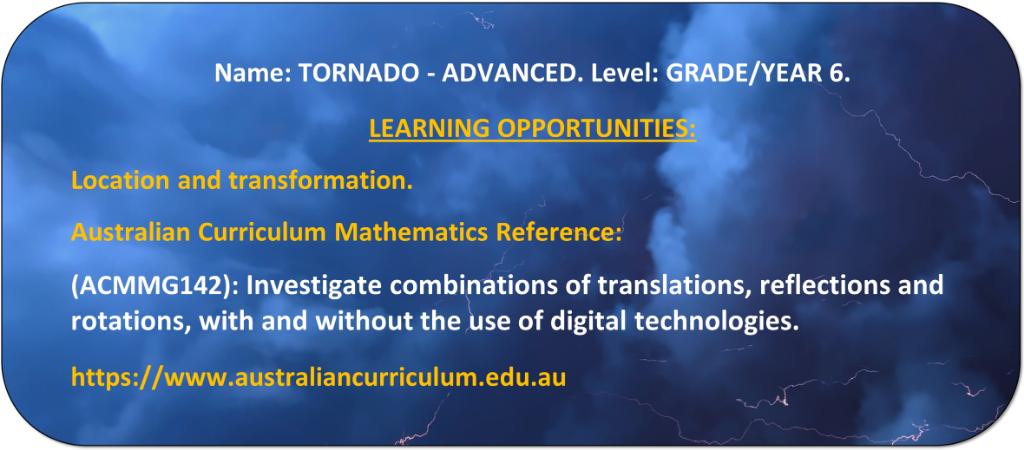
Tornado – Advanced - Worksheet
WHOLE NUMBERS – STANDARD
GAME PLAYS ON: PC, LAPTOP & TABLET
Whole Numbers – Standard - Game Description
Ages: 11 – 12 years old
Suits: Grade 6 students in Australia, Sixth Grade students in the U.S.A. & Canada and Year 7 students in England.
Problem-solving with decimals and fractions of related denominations.
This is an engaging problem-solving game using decimals and fractions of thirds, sixths, halves and quarters. It is a fun way for student to become proficient at adding and subtracting fractions of different denominations. Students must find a common denominator to begin to solve the puzzle.
It is an excellent game to develop a good understanding of working with decimals and fractions. Whilst challenging, it is still lots of fun to play. It is designed to suit the Mathematics Curriculums of Australia, Canada, England and the U.S.A.
Teacher References:
(ACMNA126): Solve problems involving addition of fractions with the same or related denominators.
(ACMNA128): Add decimals, with and without digital technologies.
Ref: Australian Curriculum Mathematics.
How To Play:
DRAG numbers into the circles so each arrow adds up to a TOTAL of 3. Then for part B of your challenge, first decide which number should go in the middle. Now each arrow must add up to a TOTAL of 2. Clue for adding fractions: Find a common denominator.
Whole Numbers – Standard - Learning Outcomes

Whole Numbers – Standard - Worksheet
WHOLE NUMBERS – ADVANCED
GAME PLAYS ON: PC, LAPTOP & TABLET
Whole Numbers – Advanced - Game Description
Ages: 11 – 12 years old
Suits: Grade 6 students in Australia, Sixth Grade students in the U.S.A. & Canada and Year 7 students in England.
Advanced problem-solving with decimals and fractions of related denominations.
This is the more challenging version of the game Whole Numbers – Standard. The combinations of decimals and fractions are more complex. It is an excellent game for teachers to gauge if a student fully understands decimals and also finding common denominations with fractions.
Although challenging, it is still within this age groups capabilities. It is designed to suit the Mathematics Curriculums of Australia, Canada, England and the U.S.A.
Teacher References:
(ACMNA126): Solve problems involving addition of fractions with the same or related denominators.
(ACMNA128): Add decimals, with and without digital technologies.
Ref: Australian Curriculum Mathematics.
How To Play:
Now you will be challenged! Clue: First decide which number might go in the middle. Then DRAG numbers into the circles so each arrow adds up to a TOTAL of 6. Then for Part B: Now each arrow must add up to a TOTAL of 3. Clue for adding fractions: Find a common denominator.
Whole Numbers – Advanced - Learning Outcomes

Whole Numbers – Advanced - Worksheet
THE ULTIMATE CHALLENGE
GAME PLAYS ON: PC, LAPTOP & TABLET
The Ultimate Challenge - Game Description
Ages: 11 – 12 years old
Suits: Grade 6 students in Australia, Sixth Grade students in the U.S.A. & Canada and Year 7 students in England.
Adding decimals to fractions to make a whole.
This is an engaging problem-solving game where students must add decimals to fractions. It is a challenging and engaging game for students. Using a hexagon puzzle, students must match either 2 fractions or 2 decimals or 1 fraction and 1 decimal so that their sum adds up to 1. The game becomes a good exercise in arithmetic as students must try many different combinations to solve the puzzle.
It is an excellent game to develop a good understanding of working with decimals and fractions. Whilst challenging, it is still lots of fun to play. It is designed to suit the Mathematics Curriculums of Australia, Canada, England and the U.S.A.
Teacher References:
(ACMNA125): Compare fractions with related denominators.
(ACMNA126): Solve problems involving addition of fractions with the same or related denominators.
(ACMNA128): Add decimals, with and without digital technologies.
(ACMNA131): Make connections between equivalent fractions and decimals.
Ref: Australian Curriculum Mathematics.
How To Play:
Are you ready for the ultimate challenge? Put six hexagons around the centre / center piece, so all touching sides are matching in colour / color AND add up to 1. DRAG the pieces to move them.
Then you can TURN each one to fit. When this box appears, click it to see if you are correct! You may round off: 0.66 + 0.33 ≈ 1
The Ultimate Challenge - Learning Outcomes

The Ultimate Challenge - Worksheet
ICY POLES – METRIC STANDARD
GAME PLAYS ON: PC & LAPTOP ONLY
Icy Poles – Metric Standard - Game Description
Ages: 11 – 12 years old
Suits: Grade 6 students in Australia & Canada.
Problem-solving involving volume & capacity.
This game helps students to become proficient at problem-solving using metric units of volume and capacity. It helps students to understand the connection between volume and capacity and their units of measurement.
Students must calculate the amount of liquid needed to make a single icy pole of various sizes. It is full of learning opportunities and positive voice-overs to build student confidence with mathematics. This game is designed to suit the Mathematics Curriculum of the Australia & Canada.
Teacher References:
Becoming proficient in advanced problem-solving with metric units of volume and capacity using a calculator.
(ACMMG138): Connect volume and capacity and their units of measurement.
(ACMMG135): Connect decimal representations to the metric system.
Ref: Australian Curriculum Mathematics.
How To Play:
You are about to make icy poles at home. But first, you must work out how much liquid you need. Click on an icy pole. Choose the correct amount of liquid you need make it. (See the CLUE.) Then drag your answer to the icy pole above
Icy Poles – Metric Standard - Learning Outcomes

Icy Poles – Metric Standard - Worksheet
ICY POLES – IMPERIAL STANDARD
GAME PLAYS ON: PC & LAPTOP ONLY
Icy Poles – Imperial Standard - Game Description
Ages: 11 – 12 years old
Suits: Year 7 students in England.
Advanced problem-solving involving volume & capacity.
This game helps students to become proficient at problem-solving using imperial units of volume and capacity. It helps students to understand the connection between volume and capacity and their units of measurement.
Students must calculate the amount of liquid needed to make a single icy pole of various sizes. It is full of learning opportunities and positive voice-overs to build student confidence with mathematics. This game is designed to suit the Mathematics Curriculum of England.
Becoming proficient in advanced problem-solving with imperial units of volume and capacity using a calculator.
Teacher References:
(ACMMG138): Connect volume and capacity and their units of measurement.
(ACMMG135): Connect decimal representations to the (imperial) system.
Ref: Australian Curriculum Mathematics.
How To Play:
You are about to make icy poles at home. But first, you must work out how much liquid you need. Click on an icy pole. Choose the correct amount of liquid you need make it. (See the CLUE.) Then drag your answer to the icy pole above
Icy Poles – Imperial Standard - Learning Outcomes
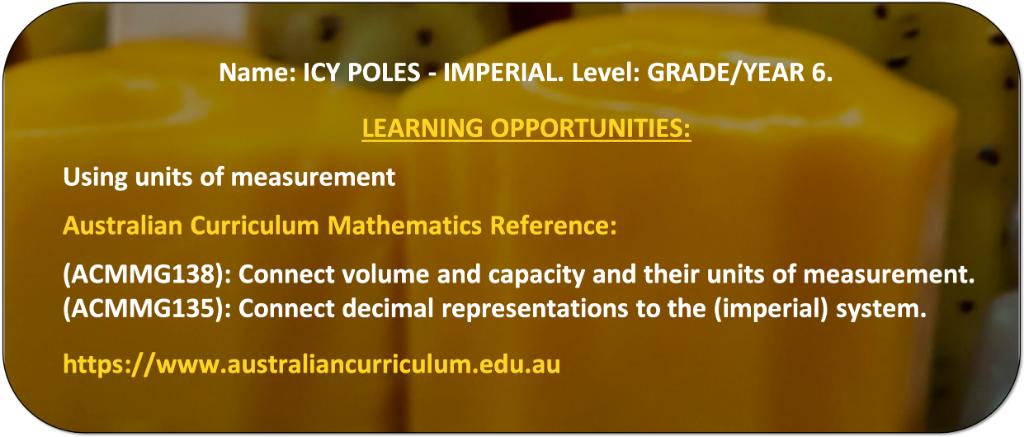
Icy Poles – Imperial Standard - Worksheet
ICY POLES – US STANDARD
GAME PLAYS ON: PC & LAPTOP ONLY
Icy Poles – US Standard - Game Description
Ages: 11 – 12 years old
Suits: Sixth Grade students in the U.S.A.
Advanced problem-solving involving volume & capacity.
This game helps students to become proficient at problem-solving using US Liquid units of measurement. It helps students to understand the connection between volume and capacity.
Students must calculate the amount of liquid needed to make a single icy pole of various sizes. It is full of learning opportunities and positive voice-overs to build student confidence with mathematics. This game is designed to suit the Mathematics Curriculum of the U.S.A.
Becoming proficient in advanced problem-solving with imperial units of volume and capacity using a calculator.
Teacher References:
(ACMMG138): Connect volume and capacity and their units of measurement.
(ACMMG135): Connect decimal representations to the (imperial) system.
Ref: Australian Curriculum Mathematics.
How To Play:
You are about to make icy poles at home. But first, you must work out how much liquid you need. Click on an icy pole. Choose the correct amount of liquid you need make it. (See the CLUE.) Then drag your answer to the icy pole above.
Icy Poles – US Standard - Learning Outcomes

Icy Poles – US Standard - Worksheet
ICY POLES – METRIC ADVANCED
GAME PLAYS ON: PC & LAPTOP ONLY
Icy Poles – Metric Advanced - Game Description
Ages: 11 – 12 years old
Suits: Grade 6 students in Australia & Canada.
Note: This game is at an advanced level and is optional for students. It is designed to be played with teacher, tutor or parent assistance. It is the most challenging game in this series for students.
Advanced problem-solving involving volume & capacity.
Students must calculate the amount of liquid needed to fill icy pole trays of various sizes. It is full of learning opportunities and positive voice-overs to build student confidence with mathematics. It also encourages students to not “give up” and it is very rewarding for students when completed. This game is designed to suit the Mathematics Curriculum of the Australia & Canada.
Teacher References:
(ACMMG138): Connect volume and capacity and their units of measurement.
(ACMMG135): Connect decimal representations to the metric system.
Ref: Australian Curriculum Mathematics.
How To Play:
You are making different size icy poles at home. You must work out how much liquid you need. Click on a set of trays. Choose the correct amount of liquid you need to fill them up. (See the CLUE.) Then drag your answer to the trays above. This challenge may be played with your teacher, tutor or parent. Don’t give up, you can do it! Your challenge is to complete the game! You can do it!
Icy Poles – Metric Advanced - Learning Outcomes

Icy Poles – Metric Advanced - Worksheet
ICY POLES – IMPERIAL ADVANCED
GAME PLAYS ON: PC & LAPTOP ONLY
Icy Poles – Imperial Advanced - Game Description
Ages: 11 – 12 years old
Suits: Year 7 students in England.
Note: This game is at an advanced level and is optional for students. It is designed to be played with teacher, tutor or parent assistance. It is the most challenging game in this series for students.
Advanced problem-solving involving volume & capacity.
Students must calculate the amount of liquid needed to fill icy pole trays of various sizes. It is full of learning opportunities and positive voice-overs to build student confidence with mathematics. It also encourages students to not “give up” and it is very rewarding for students when completed. This game is designed to suit the Mathematics Curriculum of England.
Teacher References:
(ACMMG138): Connect volume and capacity and their units of measurement.
(ACMMG135): Connect decimal representations to the (imperial) system.
Ref: Australian Curriculum Mathematics.
How To Play:
You are making different size icy poles at home. You must work out how much liquid you need. Click on a set of trays. Choose the correct amount of liquid you need to fill them up. (See the CLUE.) Then drag your answer to the trays above. This challenge may be played with your teacher, tutor or parent. Don’t give up, you can do it! Your challenge is to complete the game! You can do it!
Icy Poles – Imperial Advanced - Learning Outcomes

Icy Poles – Imperial Advanced - Worksheet
ICY POLES – US ADVANCED
GAME PLAYS ON: PC & LAPTOP ONLY
Icy Poles – US Advanced - Game Description
Ages: 11 – 12 years old
Suits: Sixth Grade students in the U.S.A.
Note: This game is at an advanced level and is optional for students. It is designed to be played with teacher, tutor or parent assistance. It is the most challenging game in this series for students.
Advanced problem-solving involving volume & capacity.
Students must calculate the amount of liquid needed to fill icy pole trays of various sizes. It is full of learning opportunities and positive voice-overs to build student confidence with mathematics. It also encourages students to not “give up” and it is very rewarding for students when completed. This game is designed to suit the Mathematics Curriculum of the U.S.A.
Teacher References:
Becoming proficient in advanced problem-solving with imperial units of volume and capacity using a calculator.
(ACMMG138): Connect volume and capacity and their units of measurement.
(ACMMG135): Connect decimal representations to the (imperial) system.
Ref: Australian Curriculum Mathematics.
How To Play:
You are making different size icy poles at home. You must work out how much liquid you need. Click on a set of trays. Choose the correct amount of liquid you need to fill them up. (See the CLUE.) Then drag your answer to the trays above. This challenge may be played with your teacher, tutor or parent. Don’t give up, you can do it! Your challenge is to complete the game! You can do it!
Icy Poles – US Advanced - Learning Outcomes

Icy Poles – US Advanced - Worksheet
THE STAR – STANDARD
GAME PLAYS ON: PC & LAPTOP ONLY
The Star – Standard - Game Description
Ages: 11 – 12 years old
Suits: Grade 6 students in Australia, Sixth Grade students in the U.S.A. & Canada and Year 7 students in England.
Gaining fluency with adding and subtracting decimals.
Students are firstly given a puzzle involving addition and subtraction with whole numbers. This is a warm-up to the more challenging Part B of the puzzle where students must add and subtract decimals.
Set in outer space, it is a fun and engaging game to play. Students must place numbers into a star pattern, so every straight line adds up to the number given. It is a good exercise to practise addition and subtraction of decimals as students must try many possible combinations to solve the puzzle. The game is designed to suit the Mathematics Curriculums of Australia, Canada, England and the U.S.A.
Teacher Reference:
(ACMNA128): Add and subtract decimals, without digital technologies. Exploring and practising efficient methods for solving problems requiring operations on decimals, to gain fluency with calculating with decimals and with recognising appropriate operations.
Ref: Australian Curriculum Mathematics.
How To Play:
A star will appear from the galaxy. Then you must place the numbers from 1 to 12 into the star so any four numbers in a straight line will add up to 26. Then your challenge is next! A new star will appear. This time you must place numbers into the star, so every straight line adds up to 2.6. See the CLUE. You will be challenged!
The Star – Standard - Learning Outcomes

The Star – Standard - Worksheet
THE STAR – ADVANCED
GAME PLAYS ON: PC & LAPTOP ONLY
The Star – Advanced - Game Description
Ages: 11 – 12 years old
Suits: Grade 6 students in Australia, Sixth Grade students in the U.S.A. & Canada and Year 7 students in England.
More advanced calculations with decimals.
This is the more challenging version of the game The Star – Standard. The combinations of decimals are more complex. It is an excellent game for teachers to gauge if a student fully understands operations of adding and subtracting with decimals.
Although challenging, it is still within this age groups capabilities. It is designed to suit the Mathematics Curriculums of Australia, Canada, England and the U.S.A.
Teacher Reference:
(ACMNA128): Add and subtract decimals, without digital technologies. Exploring and practising efficient methods for solving problems requiring operations on decimals, to gain fluency with calculating with decimals and with recognising appropriate operations.
Ref: Australian Curriculum Mathematics.
How To Play:
A star will appear. Then you must place the numbers into the star so any four numbers in a straight line will add up to 3. Then your challenge is next! A new star will appear. This time you must place numbers into the star, so every straight line adds up to 12. See the CLUE. Don’t give up, you can do it!
The Star – Advanced - Learning Outcomes

The Star – Advanced - Worksheet
SWIMMING POOL – METRIC STANDARD
GAME PLAYS ON: PC & LAPTOP ONLY
Swimming Pool – Metric Standard - Game Description
Ages: 11 – 12 years old
Suits: Grade 6 students in Australia & Canada.
Learning to solve problems involving division by one- and two-digit numbers, without using a calculator. It also includes problem solving with simple fractions.
It is very engaging, fun to play and filled with positive voice-overs to build student confidence in mathematics. It is designed to suit the Mathematics Curriculum of Australia and Canada, as it uses metric units.
Teacher References:
(ACMNA123): Select and apply efficient mental and written strategies and appropriate digital technologies to solve problems involving all four operations with whole numbers.
Apply strategies already developed for solving problems involving small numbers to those involving large numbers.
Apply a range of strategies to solve realistic problems and commenting on the efficiency of different strategies.
(ACMNA127): Find a simple fraction of a quantity where the result is a whole number.
Ref: Australian Curriculum Mathematics.
How To Play:
The hose can’t reach so you must fill your swimming pool with containers of water! Can you calculate how much water you have put in the pool so far? The pool needs 1200 L of water to fill. So how full is the pool?
Swimming Pool – Metric Standard - Learning Outcomes
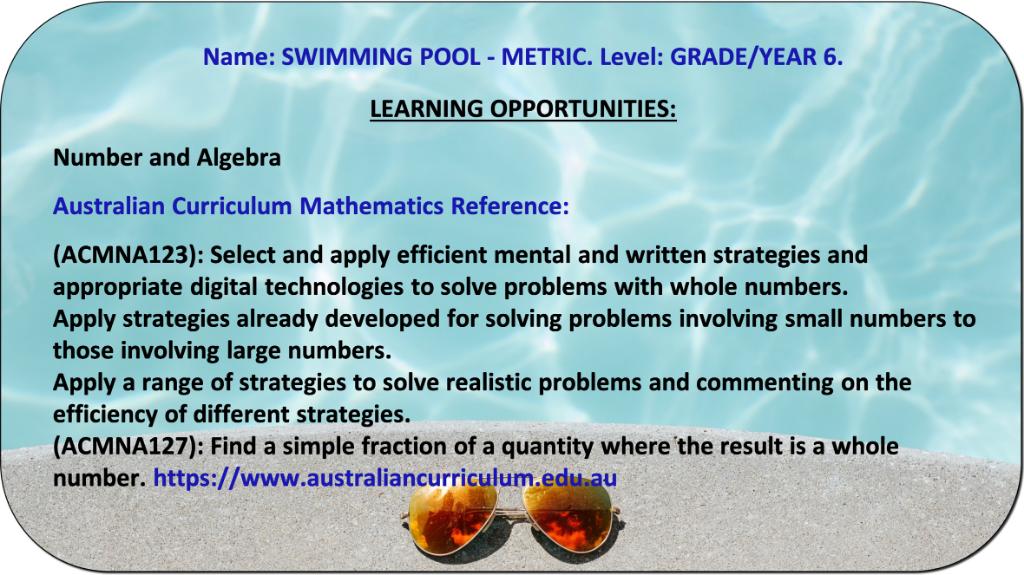
Swimming Pool – Metric Standard - Worksheet
SWIMMING POOL – IMPERIAL STANDARD
GAME PLAYS ON: PC & LAPTOP ONLY
Swimming Pool – Imperial Standard - Game Description
Ages: 11 – 12 years old
Suits: Year 7 students in England.
Learning to solve problems involving division by one- and two-digit numbers, without using a calculator. It also includes problem solving with simple fractions.
It is very engaging, fun to play and filled with positive voice-overs to build student confidence in mathematics. It is designed to suit the Mathematics Curriculum of England, as it uses imperial units.
Teacher References:
(ACMNA123): Select and apply efficient mental and written strategies and appropriate digital technologies to solve problems involving all four operations with whole numbers.
Apply strategies already developed for solving problems involving small numbers to those involving large numbers.
Apply a range of strategies to solve realistic problems and commenting on the efficiency of different strategies.
(ACMNA127): Find a simple fraction of a quantity where the result is a whole number.
Ref: Australian Curriculum Mathematics.
How To Play:
The hose can’t reach so you must fill your swimming pool with containers of water! Can you calculate how much water you have put in the pool so far? The pool needs 1200 gallons of water to fill. So how full is the pool?
Swimming Pool – Imperial Standard - Learning Outcomes

Swimming Pool – Imperial Standard - Worksheet
SWIMMING POOL – US STANDARD
GAME PLAYS ON: PC & LAPTOP ONLY
Swimming Pool – US Standard - Game Description
Ages: 11 – 12 years old
Suits: Sixth Grade students in the U.S.A.
Learning to solve problems involving division by one- and two-digit numbers, without using a calculator. It also includes problem solving with simple fractions.
It is very engaging, fun to play and filled with positive voice-overs to build student confidence in mathematics. It is designed to suit the Mathematics Curriculum of the U.S.A., as it uses imperial units of measurement.
Teacher References:
(ACMNA123): Select and apply efficient mental and written strategies and appropriate digital technologies to solve problems involving all four operations with whole numbers.
Apply strategies already developed for solving problems involving small numbers to those involving large numbers.
Apply a range of strategies to solve realistic problems and commenting on the efficiency of different strategies.
(ACMNA127): Find a simple fraction of a quantity where the result is a whole number.
Ref: Australian Curriculum Mathematics.
How To Play:
The hose can’t reach so you must fill your swimming pool with containers of water! Can you calculate how much water you have put in the pool so far? The pool needs 1200 gallons of water to fill. So how full is the pool?
Swimming Pool – US Standard - Learning Outcomes

Swimming Pool – US Standard - Worksheet
SWIMMING POOL – METRIC ADVANCED
GAME PLAYS ON: PC & LAPTOP ONLY
Swimming Pool – Metric Advanced - Game Description
Ages: 11 – 12 years old
Suits: Grade 6 students in Australia & Canada.
Learning to solve problems involving division by one- and two-digit numbers. Solving problems involving multiplication of large numbers by one- or two-digit numbers using a calculator.
This game helps students learn how to solve problems involving multiplication and division of large numbers with a calculator. It also includes conversions of volume amounts and time units.
It is very engaging, fun to play and filled with positive voice-overs to build student confidence in mathematics. It is designed to suit the Mathematics Curriculum of Australia and Canada, as it uses metric units.
Teacher References:
(ACMNA101): Solve problems involving division by a one-digit number. (This game also includes division by a two-digit number.)
(ACMNA100): Solve problems involving multiplication of large numbers by one- or two-digit numbers using efficient mental, written strategies and appropriate digital technologies.
Ref: Australian Curriculum Mathematics.
How To Play:
Your friends have come over for a swim. But the hose can’t reach so you must fill your swimming pool with a container of water! Lucky your friends are there to help. The pool needs 1200 L of water to fill. Click on one of the containers. Calculate how long it would take to fill the pool! (See the CLUE.) Then drag your answer to the container above. It’s a tricky calculation but you can do it! Are you ready for a challenge?
Swimming Pool – Metric Advanced - Learning Outcomes

Swimming Pool – Metric Advanced - Worksheet
SWIMMING POOL – IMPERIAL ADVANCED
GAME PLAYS ON: PC & LAPTOP ONLY
Swimming Pool – Imperial Advanced - Game Description
Ages: 11 – 12 years old
Suits: Year 7 students in England.
Learning to solve problems involving division by one- and two-digit numbers. Solving problems involving multiplication of large numbers by one- or two-digit numbers using a calculator.
This game helps students learn how to solve problems involving multiplication and division of large numbers with a calculator. It also includes conversions of volume amounts and time units.
It is very engaging, fun to play and filled with positive voice-overs to build student confidence in mathematics. It is designed to suit the Mathematics Curriculum of England, as it uses imperial units.
Teacher References:
(ACMNA101): Solve problems involving division by a one-digit number. (This game also includes division by a two-digit number.)
(ACMNA100): Solve problems involving multiplication of large numbers by one- or two-digit numbers using efficient mental, written strategies and appropriate digital technologies.
Ref: Australian Curriculum Mathematics.
How To Play:
Your friends have come over for a swim. But the hose can’t reach so you must fill your swimming pool with a container of water! Lucky your friends are there to help. The pool needs 1200 gallons of water to fill. Click on one of the containers. Calculate how long it would take to fill the pool! (See the CLUE.) Then drag your answer to the container above. It’s a tricky calculation but you can do it! Are you ready for a challenge?
Swimming Pool – Imperial Advanced - Learning Outcomes

Swimming Pool – Imperial Advanced - Worksheet
SWIMMING POOL – US ADVANCED
GAME PLAYS ON: PC & LAPTOP ONLY
Swimming Pool – US Advanced - Game Description
Ages: 11 – 12 years old
Suits: Sixth Grade students in the U.S.A.
Learning to solve problems involving division by one- and two-digit numbers. Solving problems involving multiplication of large numbers by one- or two-digit numbers using a calculator.
This game helps students learn how to solve problems involving multiplication and division of large numbers with a calculator. It also includes conversions of volume amounts and time units.
It is very engaging, fun to play and filled with positive voice-overs to build student confidence in mathematics. It is designed to suit the Mathematics Curriculum of the U.S.A., as it uses US Liquid units of measurement.
Teacher References:
(ACMNA101): Solve problems involving division by a one-digit number. (This game also includes division by a two-digit number.)
(ACMNA100): Solve problems involving multiplication of large numbers by one- or two-digit numbers using efficient mental, written strategies and appropriate digital technologies.
Ref: Australian Curriculum Mathematics.
How To Play:
Your friends have come over for a swim. But the hose can’t reach so you must fill your swimming pool with a container of water! Lucky your friends are there to help. The pool needs 1200 gallons of water to fill. Click on one of the containers. Calculate how long it would take to fill the pool! (See the CLUE.) Then drag your answer to the container above. It’s a tricky calculation but you can do it! Are you ready for a challenge?
Swimming Pool – US Advanced - Learning Outcomes

Swimming Pool – US Advanced - Worksheet
By the end of Grade 6, students recognise the properties of prime, composite, square and triangular numbers. They describe the use of integers in everyday contexts. They solve problems involving all four operations with whole numbers. Students connect fractions, decimals and percentages as different representations of the same number. They solve problems involving the addition and subtraction of related fractions. Students make connections between the powers of 10 and the multiplication and division of decimals. They describe rules used in sequences involving whole numbers, fractions and decimals. Students connect decimal representations and choose appropriate units of measurement to perform a calculation. They make connections between capacity and volume. They solve problems involving length and area. Students describe combinations of transformations. They solve problems using the properties of angles. Students compare observed and expected frequencies. They interpret and compare a variety of data displays including those displays for two categorical variables. They interpret secondary data displayed in the media. Students locate fractions and integers on a number line. They calculate a simple fraction of a quantity. They add, subtract and multiply decimals and divide decimals where the result is rational. Students calculate common percentage discounts on sale items. They write correct number sentences using brackets and order of operations. Students locate an ordered pair in any one of the four quadrants on the Cartesian plane. They construct simple prisms and pyramids. Students describe probabilities using simple fractions, decimals and percentages.
https://www.australiancurriculum.edu.au




























